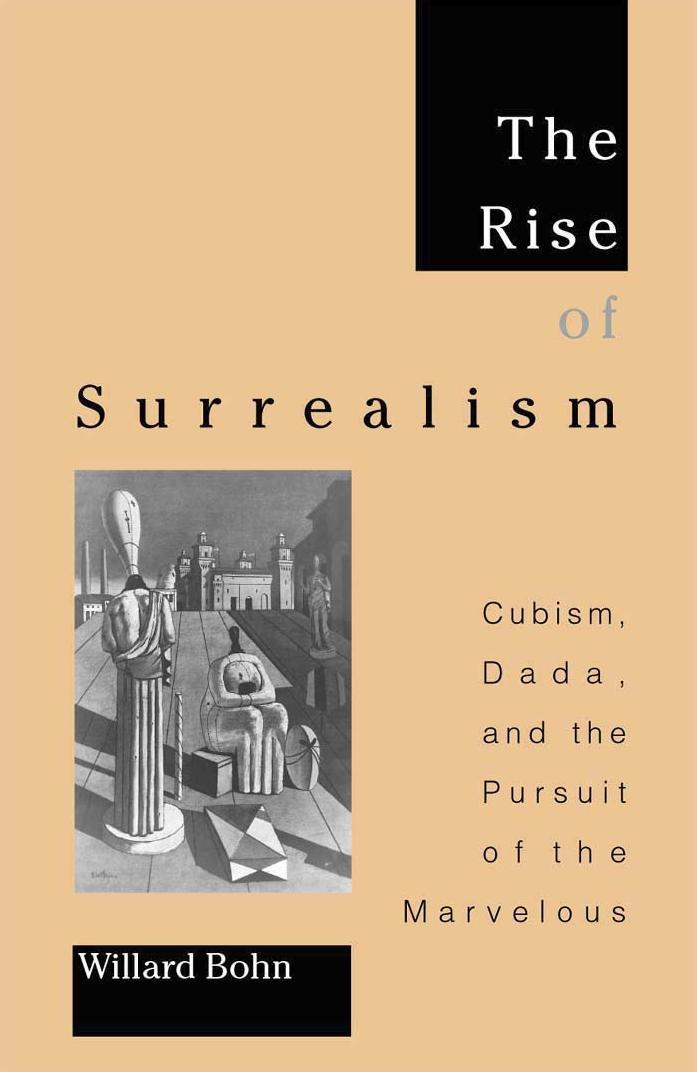Rise of Surrealism by Bohn Willard

Author:Bohn, Willard [Bohn, Willard]
Language: eng
Format: mobi, epub, pdf
Published: 0101-01-01T00:00:00+00:00
8
T H E H O U R O F T H E S P H I N X
A n d r é B r e t o n a n d J o a n M i r ó
Le chat rêve et ronronne dans la lutherie brune. Il scrute le fond de
l’ébène et de biais lape à distance le tout vif acajou. C’est l’heure où
le sphinx de la garance détend par milliers sa trompe autour de la
fontaine de Vaucluse et où partout la femme n’est plus qu’un calice
débordant de voyelles en liaison avec le magnolia illimitable de la nuit.
(The cat is dreaming and purring in the brown stringed-instrument
trade. It scrutinizes the depth of the ebony and from a distance laps
the living mahogany obliquely. It is the hour when the madderwort
sphinx loosens by the thousands her horn around the fountain of
Vaucluse and when woman everywhere is no longer anything but a
chalice overflowing with vowels in connection with the illimitable
magnolia of the night).1
In 1958, André Breton wrote twenty-two poems inspired by a brilliant series
of gouaches that Joan Miró had created nearly twenty years earlier. Collected
the following year in Constellations, each poem was juxtaposed with the ap-
propriate painting in a mathematical progression based on skill and chance,
intention and accident.2 If, as Anna Balakian states, “Breton’s Constellations is a
cosmic venture in which man joins nature through his manipulation of lan-
guage,” the same may be said of Miró’s paintings in which birds, women, and
195
196
T H E R I S E O F S U R R E A L I S M
stars offer a privileged view of the universe. This is particularly true of
“Femme et oiseau” (“Woman and Bird”), the eighth poem in the series,
whose title unites two of the artist’s favorite motifs (see Chapter 7).3 Through-
out the volume verbal language complements visual language in an elaborate
pas de deux . That Breton’s intention was not simply to evoke Miró’s art or to
reproduce relevant themes may be seen from the term he chose to describe his
creations: “proses parallèles.” As such they represent independent meditations
on subjects suggested by the paintings without any attempt to follow the path
taken by the artist. Stressing the profound originality of Breton’s undertak-
ing, J. H. Matthews describes this reciprocal relationship as follows: “The
image before his eyes liberates images within, and it is the latter that he seeks
to capture, in acknowledgement of the former’s evocative quality.”4
According to Philippe Audoin, each text takes its point of departure from
one of three sources: the painting’s title, its general tonality, or one or more
graphic elements.5 This explains why the title “Femme et oiseau” makes no
sense—it is entirely incidental. The poet does refer to a woman toward the
end, but she is only one of several characters who are equally important. Not
only is the bird nowhere to be found, but there is no indication that it will
ever appear. Although Breton appropriates Miró’s title for his poem, as he did
throughout the book, it was clearly not the source of his inspiration. Contin-
uing our inquiry in a similar vein, we can also rule out tonality as a potential
source.
Download
Rise of Surrealism by Bohn Willard.epub
Rise of Surrealism by Bohn Willard.pdf
This site does not store any files on its server. We only index and link to content provided by other sites. Please contact the content providers to delete copyright contents if any and email us, we'll remove relevant links or contents immediately.
| Ancient & Classical | Arthurian Romance |
| Beat Generation | Feminist |
| Gothic & Romantic | LGBT |
| Medieval | Modern |
| Modernism | Postmodernism |
| Renaissance | Shakespeare |
| Surrealism | Victorian |
4 3 2 1: A Novel by Paul Auster(12260)
The handmaid's tale by Margaret Atwood(7660)
Giovanni's Room by James Baldwin(7158)
Asking the Right Questions: A Guide to Critical Thinking by M. Neil Browne & Stuart M. Keeley(5598)
Big Magic: Creative Living Beyond Fear by Elizabeth Gilbert(5575)
Ego Is the Enemy by Ryan Holiday(5263)
The Body: A Guide for Occupants by Bill Bryson(4940)
On Writing A Memoir of the Craft by Stephen King(4846)
Ken Follett - World without end by Ken Follett(4617)
Adulting by Kelly Williams Brown(4462)
Bluets by Maggie Nelson(4456)
Eat That Frog! by Brian Tracy(4407)
Guilty Pleasures by Laurell K Hamilton(4335)
The Poetry of Pablo Neruda by Pablo Neruda(4016)
Alive: The Story of the Andes Survivors by Piers Paul Read(3953)
White Noise - A Novel by Don DeLillo(3933)
Fingerprints of the Gods by Graham Hancock(3922)
The Book of Joy by Dalai Lama(3879)
The Bookshop by Penelope Fitzgerald(3757)
